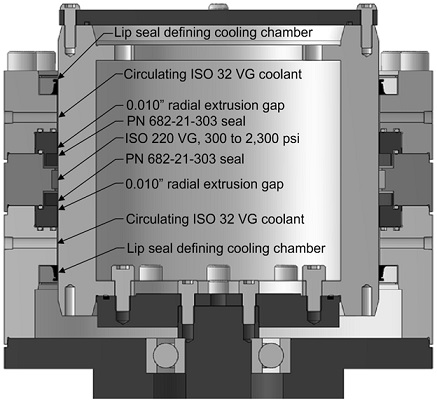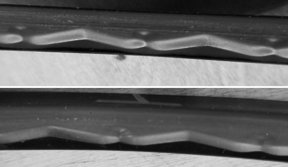Introduction
We test our RCD seals in a variety of conditions, to ensure that our customers can meet their goals for the dynamic pressure rating test established by API Specification 16RCD (Specification for Drill Through Equipment—Rotating Control Devices). Since we are conducting full-scale tests, we are also learning useful things about implementing RCD seals in large diameter equipment. Our most recent test, VF22, is a good example of the learning process.
The objective of test VF22 was two-fold. First, we wanted to see if a particular type of Plastic Lined Seal™ could last 200 hours at 100 rpm with an ISO 220 viscosity grade seal lubricant at 2,300 psi (15.86 MPa) when exposed to a 0.010” (0.25mm) radial extrusion gap clearance. Second, we wanted to collect data on the hydrodynamic pumping related leak rate at lower pressures and higher speed. These objectives were met, and demonstrate that the test seals can tolerate 2,300 psi and 100 rpm well beyond the 100-hour minimum duration that API 16RCD requires.
The 2,300 psi test pressure was selected for duration testing because it replicates an RCD with 300 psi (2.07 MPa) lubricant overpressure and 2,000 psi (13.79 MPa) wellbore pressure.
The seal implementation lesson we learned
A pair of PN 682-21-303 rotary seals were tested with outboard coolant circulation. Although outboard of the seals, this circulation was intended to approximate an RCD cooled by circulation of the bearing lubricant.
In VF22, our outboard coolant was an ISO 32 viscosity grade lubricant. As a result of the viscous nature of this coolant, it could not be circulated at the desired flow rate, because the resulting pressure would eject the conventional lip seals retaining the coolant. The necessarily low flow rate provided insufficient cooling during the high speed portion of the test, resulting in excessive temperature. The moderate seal damage that was observed at the conclusion of the test may have occurred early on, during the low pressure, high speed portion of the test.
The lessons in all this are that (1) any secondary seal that defines an outboard coolant circuit must be robust enough to withstand the pressure of the coolant; and (2) when a lubricant is used as a circulating coolant, the lubricant viscosity may cause the pressure of the coolant to increase significantly. We believe a water/antifreeze mixture may be preferable as an outboard coolant because of its low viscosity.
The configuration of the seal test fixture
A cross-section of the seal test fixture is shown below as Figure 1. The fixture is configured to test a pair of high pressure RCD seals at a time, with the pressurized seal lubricant located between the seals. The seal carriers used in this test are of the fixed, non-floating variety, and have a 0.010” nominal radial clearance with respect to the shaft. Conventional metal-cased lip seals define annular outboard cooling regions where the lubricant-based coolant was circulated during the test.
The test ran for a total of 266 hours at four different pressures, and was terminated when the goal of 200 hours at 2,300 psi was achieved. Shaft runout (T.I.R.) was 0.007” (0.18mm) at the location of the upper test seal, and 0.003” (0.08mm) at the location of the lower test seal.
Description of the low pressure, high speed portion of the test
The first portion of the test was conducted at 300 psi and 170 rpm. During this portion of the test, the outboard flow rate was insufficient, and the bulk lubricant temperature between the test seals increased to 288°F (142.2°C) six hours after commencement of the test. We were able to increase the coolant flow rate moderately without ejecting the lip seals that define the coolant circuits. This brought the bulk temperature down to 252°F (122.2°C).
We suspect, but can’t be sure, that the moderate damage to the pressure retaining seals that was observed at the conclusion of the 266-hour test may have occurred during this initial period. If true, this damage may explain the lower than anticipated hydrodynamic pumping related seal leak rate that was observed. At 300 psi and 170 rpm, the leak rate was only 0.47 ml/hr. This was the highest leak rate observed at any pressure and speed combination.
Description of the high pressure portion of the test
After the low pressure portion of the test, the rotary speed was reduced to 100 rpm. The seals were exposed to 1,000 psi for 20.05 hours, 1,500 psi for 29.37 hours, and 2,300 psi for 200.42 hours. The average bulk lubricant temperature between the seals was 208°F at 1,000 psi, 220°F at 1,500 psi, and 227°F at 2,300 psi. We believe that considerably lower bulk temperatures can be achieved in an actual RCD, because of the higher coolant flow rate that is available. Lower operating temperature will likely increase the seal leak rate.
The condition of the used seals at the conclusion of the test is shown below, in Figure 2. Although the seals exhibit light to moderate wear, they were still fully functional at the conclusion of the test. In other tests, we have witnessed seals with the -303 composite material construction continue to seal after suffering much more wear than the seals in test VF22. Our currently evolving opinion is the -303 material seems to be able to tolerate more damage than the -318 material, and continue to function.
Conclusions
This test shows that the PN 682-21-303 RCD seal can last 200 hours at 100 rpm with an ISO 220 viscosity grade seal lubricant at 2,300 psi (15.86 MPa) when exposed to a 0.010” (0.25mm) radial extrusion gap clearance, with very little cooling. Contact our staff for additional information. For available sizes of RCD seals, see our shaft seal catalog.


